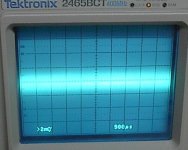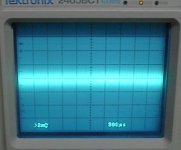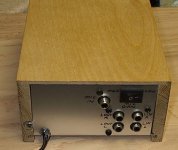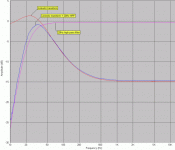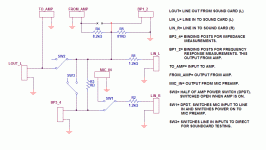4fun said:
Hi John,
I hope you are aware that a motherboard with Intel 815 chipset can only address up to 512MB memory. It may not be an issue for you but maybe worth mentioning.
Thanks, I didn't know that. It's not a problem though, as I only have 192MB of PC100 on the current board.
Nice part of any Intel board is their on going support, with regard to drivers and BIOS updates.
The board I'm looking at on Ebay comes with a CPU and ram. Some spares to have on hand.
MJL21193 said:What sound card are you using? I had an old Thinkpad 780ed that I tried before with an Audigy PCMCIA card, but it wouldn't work - processor wasn't fast enough (PII, 266MHz). I gave up on that and switched to a desktop, but I'm having issues with that too.
It's an M-Audio Transit, and it seems to work pretty well. The laptop is an old P3 with 256meg of memory- the only annoying thing is that SE opens all its windows expecting a larger screen size than 1024x768 so I have to keep moving everything around, and occasional glitches when the MLS doesn't seem to sync properly. But it is usable.
Chris, I agree, if I wasn't using up surplus parts, I would have done it differently. However it's not as bad as you might think, the traffo is fully screened, and after tweaking the lead dress 50/100Hz pickup is tiny in RMAA.
Hi Al,
Yours does not seem to be as cramped.
I know bench space is always at a premium. That's why I try to design things to fit in places that are standard or not used. If you have a laptop, then it probably runs warm and having another item do double duty (cooling the laptop), without taking up any more room than is already spoken for seems very attractive.
I stuck my USB 'scope into a small 1U 19" rack space and screwed it above another piece. I didn't lose any bench space by doing this.
Hi John,
Yes, if you have to carry it about, then small is good. All you need now are rounded edges.
-Chris
Yours does not seem to be as cramped.
I know bench space is always at a premium. That's why I try to design things to fit in places that are standard or not used. If you have a laptop, then it probably runs warm and having another item do double duty (cooling the laptop), without taking up any more room than is already spoken for seems very attractive.
I stuck my USB 'scope into a small 1U 19" rack space and screwed it above another piece. I didn't lose any bench space by doing this.
Hi John,
Yes, if you have to carry it about, then small is good. All you need now are rounded edges.
-Chris
anatech said:Hi John,
I bought a 2.8 GHz computer complete for about $150 CDN. Locally. It also had the XP lic. stuck on the outside of the case.


This would seem to be a better move.
-Chris
Where's the DIY fun in that??

When I upgrade this computer, I'll move this one down there. This one still has a year or two left in it though. The Ebay mobo is the cheapest solution for me right now, providing I can get it for the right price.
The P3 doesn't have any problem handling the programs I'll run on it - RMAA, SW, RTA and eventually Arta.
pinkmouse said:
It's an M-Audio Transit,
However it's not as bad as you might think, the traffo is fully screened, and after tweaking the lead dress 50/100Hz pickup is tiny in RMAA.
Laptop is probably the best fr this purpose (mobility). Maybe I keep my eye open for a reasonably priced one.
Noise. Here's how much noise there is in the operating jig. This is with the mic preamp connected to the LM3886 which is connected to my shop speaker. No mic connected.
Attachments
Hi John,
The 'scope will not tell you very much at all. Connect the HP to it and look for real answers. Oscilloscopes are not known to be terribly sensitive instruments. Also, you can't pick anything out of the noise there.
I'm not saying you will find noise, I'm just suggesting a better instrument for the job.
With any luck, I might be getting a working HP 3585A some day soon. I did pick up an HP 3580A (early) that doesn't work well. Can't use it. The 3562A is the other instrument I really, really want to pick up. Some day.
-Chris
The 'scope will not tell you very much at all. Connect the HP to it and look for real answers. Oscilloscopes are not known to be terribly sensitive instruments. Also, you can't pick anything out of the noise there.
I'm not saying you will find noise, I'm just suggesting a better instrument for the job.
With any luck, I might be getting a working HP 3585A some day soon. I did pick up an HP 3580A (early) that doesn't work well. Can't use it. The 3562A is the other instrument I really, really want to pick up. Some day.
-Chris
anatech said:Hi John,
The 'scope will not tell you very much at all. Connect the HP to it and look for real answers. Oscilloscopes are not known to be terribly sensitive instruments. Also, you can't pick anything out of the noise there.
Hi Chris,
The scope is the only thing I have, other than my ears. Usually, when my ears hear no noise, I don't bother to connect the scope. It's hard to quantify what I hear though (they are MY ears, after all
The scope will show the magnitude of any noise that's being produced. In this case, about 2mV peak.
All things considered, thats pretty good.
Do you know of any PC based spectrum analyzer that could suit my limited needs? I know you have the PC oscilloscope, which seems to work very well. Something in that same class would be fine for me.
This post needs a pic
Here's the back of the completed unit. Labeled the jacks and switch by hand with a sharpie.
Attachments
MJL21193 said:Do you know of any PC based spectrum analyzer that could suit my limited needs? I know you have the PC oscilloscope, which seems to work very well.
Have a look at Right Mark Audio Analyser. I use it a lot.
pinkmouse said:
Have a look at Right Mark Audio Analyser. I use it a lot.
Duh! Where's the smiley what slaps himslf in the head? I use RMAA. I forgot what it is.
Hi John,
Best of luck on that. If it works, you'll be just fine.
That 'scope I'm using is the DSO-2150 USB. Newer software for it will probably fix the only things that bug me about it. Overall, it's pretty nifty.
The only problem with using a sound card is the high frequency limitations. You might be able to get up to 96 KHz with a really nice card. My EMU1212 just came and I haven't even had a chance to test it yet. The SoundBlaster X-FI Music Extreme will run 24 bit at 96 KHz, which is excellent for a sound ard. One of the few Soundblaster products that doesn't resample (That I know of). I have tried others and always end up with a filter just over 20 KHz. Next to useless!
Next to useless!
-Chris
Best of luck on that. If it works, you'll be just fine.
That 'scope I'm using is the DSO-2150 USB. Newer software for it will probably fix the only things that bug me about it. Overall, it's pretty nifty.
The only problem with using a sound card is the high frequency limitations. You might be able to get up to 96 KHz with a really nice card. My EMU1212 just came and I haven't even had a chance to test it yet. The SoundBlaster X-FI Music Extreme will run 24 bit at 96 KHz, which is excellent for a sound ard. One of the few Soundblaster products that doesn't resample (That I know of). I have tried others and always end up with a filter just over 20 KHz.
-Chris
I've had a case and parts ready with intention of merging the jig/amp/mic preamp into an all-in-one jobby for well over a year now - but still little progress.
Good to see some people getting on with it
 The new revised PCB's should be here soon if you're up for testing one?
The new revised PCB's should be here soon if you're up for testing one?
I'll be using a lm3875 for the amp. Thinking aloud, perhaps using 2-3 attenuator switches for output @2.83v. I use a EMU0404 USB which has external gain/attenuator controls which I always leave fixed for measuring.
David, could you expand on how you've done the "spectrum analyser function for measuring the frequency response of active crossovers and the like...."
V
Good to see some people getting on with it
More than not dissimilar, it's exactly Eric Wallin's design.pinkmouse said:My mic pre is the kit that Vikash sells, AFAIK, it's not disimilar to the Wallin one
I'll be using a lm3875 for the amp. Thinking aloud, perhaps using 2-3 attenuator switches for output @2.83v. I use a EMU0404 USB which has external gain/attenuator controls which I always leave fixed for measuring.
David, could you expand on how you've done the "spectrum analyser function for measuring the frequency response of active crossovers and the like...."
V
Back when LoudspeakerLab was a viable product, it came with a combination mic preamp/impedance bridge/amplifier so that you could do your impedance measurements without needing a seperate amplifier. The concept was great, however reliability of the units was not so great with mine dying three times before I gave up on it and got a mic preamp from Phil Bamberg/BESL.
Regards,
Dennis
Regards,
Dennis
Vikash said:The new revised PCB's should be here soon if you're up for testing one?
Time, time, time - I never have enough of it these days, but I might be able to fit it in somewhere!
I thought about using gain setting switches, but ended up using a pot just to get going, otherwise I would still be dithering around. Maybe MkII.
The rotary switches are the best choice or extra functionality.
Two rotary switches certainly make the jig easy to use but they're not really suitable for switching high currents (like the driver test signal) or delicate signals (like the mic feedback signal). The redesign that I'm working on will have the rotary switches control relays in a couple of these situations.
could you expand on how you've done the "spectrum analyser function
I wish I could claim genius on my part but it's really simple! Look at the schematic I posted on the first page: the top switch position of SW2A connects the soundcard output to the active crossover input via J4 (and back to the S/C reference input) and the soundcard measurement input connects to the XO output via J5. In SpeakerWorkshop, create a new driver and simply do a nearfield frequency response measurement. I've only used SW for this but the same trick will almost certainly work with ARTA. The attached pic shows three unsmoothed filter responses for my sub XO: 20Hz high pass filter, a Linkwitz transform and the result of both circuits in series.
Using SW does not give real-time results as you need to wait for acquisition of the MLS signal and additional processing time but SpectraLAB from http://www.soundtechnology.com gives immediate results.
Nice one,
David.
Attachments
Don't mean to offend, but there is a section of the original schematic that doesn't quite make sense to me, so I revised it.
Please confirm that the attached drawing is correct.
If I am wrong the please ignore this drawing. But at the same time, do explain the purpose of this section of the circuit and the R4/R5 voltage divider that seems to do nothing.
Again, if I'm way off base, then just ignore this.
Steve/bluewizard
Please confirm that the attached drawing is correct.
If I am wrong the please ignore this drawing. But at the same time, do explain the purpose of this section of the circuit and the R4/R5 voltage divider that seems to do nothing.
Again, if I'm way off base, then just ignore this.
Steve/bluewizard
Attachments
Hi Steve,
Voltage divider R4 and R5 form the "voltage probe" for input to the left channel during frequency response testing. It samples the full signal that goes from the amp to the speaker (BP1_2).
The changes made would route the amps output through R4 to the speaker - not good.
I have been working on a board layout that will consolidate the jig, amp and preamp on one board. I'll post details when it's done.
Voltage divider R4 and R5 form the "voltage probe" for input to the left channel during frequency response testing. It samples the full signal that goes from the amp to the speaker (BP1_2).
The changes made would route the amps output through R4 to the speaker - not good.
I have been working on a board layout that will consolidate the jig, amp and preamp on one board. I'll post details when it's done.
- Status
- This old topic is closed. If you want to reopen this topic, contact a moderator using the "Report Post" button.
- Home
- Loudspeakers
- Multi-Way
- Re-Jigging the jig: Speaker testing device for Arta, Speaker Workshop & HOLMImpulse
